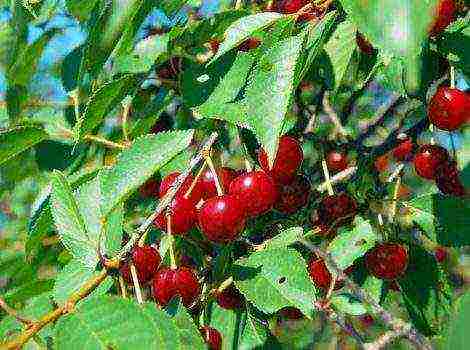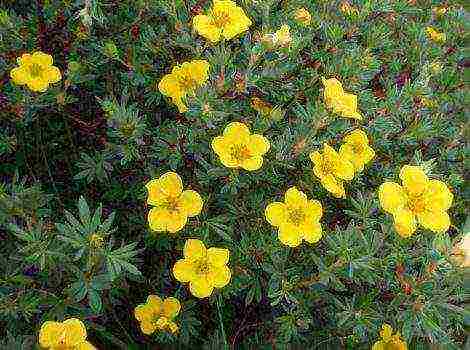Content
November 18, 2011
The best tobacco in the world
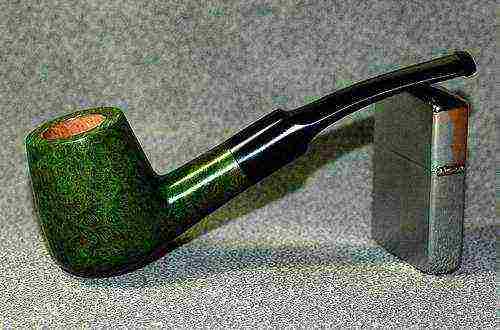
There are different varieties of tobacco, which have their own varieties. All of them differ in numerous parameters, the main of which are: the color and size of the leaves, the chemical composition of the substances in them that determine the taste and aroma of cigarettes, as well as the method of processing. Virginia Tobacco is the most popular and widely used tobacco variety. Today, its share is more than 70% of all tobacco grown in the world.
Virginia is the base for most tobacco blends. This variety gained its popularity due to its natural sweetish taste and pleasant subtle aroma. Virginia is grown on almost every continent (with the exception of Antarctica). Tobacco of this variety is cultivated in the North American states, South Africa, Brazil, India, China, Moldova, Azerbaijan.
The best Virginia grows in areas where the relative humidity is about 90 percent, and the temperature during the growing season is kept within 35 degrees Celsius. Such natural conditions exist in the states of Georgia, South and North Carolina, Zimbabwe, Malawi and Brazil.
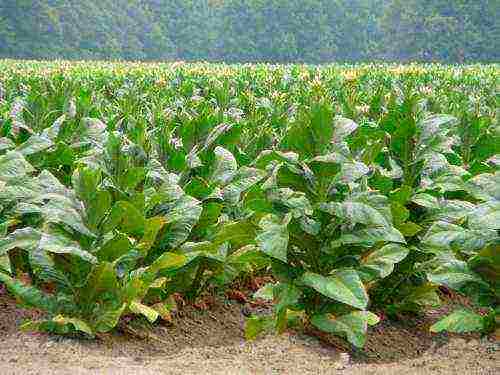
The strength of this tobacco depends on what time it is harvested, what type of drying is used, and how long the plant material undergoes fermentation.
Drying Virginia is carried out in two ways - outdoors or under the influence of hot air in specially equipped rooms. In most cases, the second method is used: the leaves are collected in bundles, suspended in rooms where hot air is supplied for five days. The quality of the future tobacco depends on the temperature and humidity in the room. If the tobacco dries for a long time, the taste becomes stronger and the aroma richer. With short-term hot drying, Virginia somewhat loses its strength and juiciness of aroma, retains a sweet taste with fruity tints.
After drying, the tobacco leaves are kept in sheds so that they gain moisture again. And then they are stored at the factory for a year or two. And only after that they are subjected to further processing. Thanks to its light and self-contained taste, Virginia is a part of every pipe mix, and also smokes excellently in its pure form.

Despite the abundance of pipe tobaccos, the base varieties are limited. What is sold is mainly mixtures with different proportions and flavors. The original qualities of pipe tobaccos depend on the tobacco variety as a plant and on the drying and fermentation processes.
So, there are the following basic varieties of tobacco:
VirginiaThe most common variety. It has a soft, delicate, sweetish taste (sugar content reaches 20%!) And a pleasant fruity aroma. The best varieties of this tobacco are surprisingly fragrant. The color of "Virginia" is usually called sunny, because its color range - from lemon to bright orange - makes it easy to see it in any mixture. Today "Virginia" is one of the main constituents of any pipe tobacco.
Virginia tobacco is grown wherever the climate permits, but the best tobaccos grow in Zimbabwe, Brazil, North and South Carolina and Georgia (USA). As mentioned above, "Virginia" is rich in dextrose (sugar), and the nicotine content ranges from 1 to 3 percent (average 2%).
Virginia tobacco processing technology is quite traditional. To preserve the “sunny” color, oily and sweetish taste, tobacco leaves are dried using the flure-curing method: after harvesting, the leaves are hung in sheds, where hot air is blown through metal pipes. After a few days, drying ends, and the leaves are kept for some time in sheds, which allows them to collect some moisture from the air. The dried leaves are sent to tobacco factories, where they are aged for one to two years.After aging, the leaves are separated from the stems (“plucked”) and subjected to pre-sale preparation - sorted by quality and color.
BurleyThis tobacco has a special, rich nutty flavor. The color of the tobacco is brown with a matte shade. The nicotine content in this tobacco ranges from 1.5 to 4 percent, but there is practically no sugar in this type of tobacco, so it is always enriched with one or another sweetener. Due to the lack of sugar, Burley's flavor is significantly drier and denser than Virginia.
Burley tobacco ranks second after Virginia tobacco in terms of content in pipe blends. This variety of tobacco is grown in the states of Kentucky, Tennessee, North Carolina, Virginia and Missouri (USA), as well as in Mexico and Malaya.
When processing burley tobacco, a natural drying method is used: freshly harvested leaves are hung in large open sheds, where within one to two months the leaves reach the required degree of moisture due to the natural movement of air. Then the tobacco is aged, split and sorted. The color range of Burley tobacco is from light brown to mahogany.
LatakiaOne of the most famous varieties of so-called “spicy” tobaccos, commonly used in English-style blends. "Latakia" is considered to be a pirate tobacco, the aroma of which is not only felt, but is the leader in any mixture - if, of course, its quantity is significant.
At this time, plantations of this "Latakia" exist only in Cyprus and Syria. After harvesting, the tobacco leaves are dried in the sun, and then brought to condition in a dense stream of smoke from a burning tree (oak, pine, myrtle, cypress), which covers the leaves with soot (a kind of "hot smoked" tobacco). Drying continues until the leaves darken and takes about two months on average.
The aroma of "latakia" is very peculiar, masculine, somewhat reminiscent of the smell of incense. Not everyone likes this tobacco, but the British revered it, and so much so that it is an indispensable component of English mixtures mixture. The content of this tobacco in them reaches 40-50% and more. If you like to experiment, you can try pure latakia, but keep in mind: this is a very strong tobacco, which also dries the nasopharynx and does not burn well. But in such mixtures as “My Mixture No. 965”, “Early Morning Pipe”, “London Mixture” by Dunhill “latakia” reveals all its advantages.
"Perique"An unusually fragrant and extremely rare variety of tobacco. Its black color and tough skin-like texture contrast strikingly with a subtle and sophisticated aroma, which is a cross between the aroma of dried fruit compote and the aroma of mushroom sauce, and the aroma is very strong. The nicotine content in tobacco of this variety is very high, therefore, its additives in the mixture are, as a rule, no more than 5%.
OrientalThe name of this tobacco variety reflects its origin - but not in the sense of the cardinal direction, but in the sense of the Eastern Mediterranean: its homeland is Greece, Cyprus, Turkey, where it is still grown, plus the countries of the Balkan Peninsula. According to the technology, the leaves of this tobacco are dried in the sun and in mixtures they have a color from greenish-yellow to golden-brown. The sugar content in this tobacco is slightly less than in Virginia tobacco, so it is distinguished by a sweet and sour taste and the smell of dusty dry grass, reminiscent of the smell of incense or incense. Small quantities of Oriental tobacco are added to all English blends, for example in English Mixture and Oriental Mixture.
KentuckyThis type of tobacco is nothing more than a specially processed “Burleigh” tobacco. It is produced in the USA (of course, in the state of Kentucky), in Malaysia and in some other countries.The peculiarity of the Kentucky tobacco production technology is that it uses not air drying, as in the case of Burley tobacco, but fire drying. The smoky smell of this tobacco is less pronounced than that of the “latakia” variety, but it is quite distinguishable and rather peculiar. The variety is distinguished by a relatively high nicotine content, therefore it is added to the mixture in small quantities.
Cavendish
Although the Cavendish is considered a separate kind of tobacco, in fact, it is only a specially processed Virginia or Burleigh tobacco (sometimes other tobaccos serve as the basis for Cavendish, which, for example, is typical for Dutch blends). The history of the emergence of this type of tobacco is very absurd and therefore doubly remarkable. Cavendish is the name of the English captain. His ship was sailing from the Caribbean to England with a cargo of empty rum barrels. The captain decided not to carry the "emptiness" and put the tobacco in the barrels. Upon arrival in England, it turned out that aging in barrels was good for the tobacco. It was not just saturated with the smell of rum - the tropical heat and regular "airing" of the compressed tobacco during storms made it softer and more aromatic. In fact, the tobacco shipment underwent repeated fermentation, which lowered the levels of nicotine and starch in the tobacco leaves and released all of the volatile aromatic compounds in tobacco, and Cavendish tobacco was born.
Today, all American-style Cavendishes are made with a large amount of molasses and flavors, so that this tobacco has a characteristic caramel flavor with soft nutty tones. It is worth noting that not all American Burleigh-based Cavendishes are processed with artificial flavors - the status of natural, for example, invariably preserves tobacco from the Green River Valley in Kentucky. Almost all Cavendishes created on the basis of Virginia tobacco are natural. No artificial flavors or additives are used in the production process.
Black Cavendish is also made from the Virginia variety, which is so called because of the characteristic dark color of the leaves that have undergone special processing. Moreover, tobaccos for Black Cavendish can be dried both in the air and in drying chambers, and even over an open fire using the fire-curing method - this does not matter of principle (except that after pipe-fire drying, Cavendish acquires, as they say, barely noticeable smoke in the aroma). It is important that during the preparation of dark natural Cavendish, Virginia tobacco first undergoes repeated fermentation, and then it is stored compressed in dark rooms for much longer than any other tobacco. The resulting Black Cavendish is a very aromatic, thick, full and surprisingly soft tobacco with pronounced spicy tones. To enhance the richness and spice of the Cavendish, many manufacturers deliberately increase the maximum temperatures at which fermentation takes place.
In a tobacco blend, Cavendish or Black Cavendish can be used to add flavor and aroma to the cocktail. Almost no English, Danish and Scottish mixture can do without dark Cavendish - and they, as you know, are distinguished by their rich taste and thick aroma. (c) Sergey Smyslov.
There are many varieties of tobacco. Below are the varieties suitable for our climate:
Virginia 202
A variety of the Krasnodar Institute of Tobacco and Makhorka. Early ripe, picks up strength and aroma very well. Resistant to many diseases. High in carbohydrates. Adapted to growing with little or no watering. Very reliable, unpretentious.
This variety belongs to dark Virginias, which have a darker mahogany hue, rich aroma and medium strength. At home, a fire dryer can be replaced with a solar one.Drying in a greenhouse or between window frames gives a good result; in the heat, the main thing is to provide humidification with the help of containers with water. The longer the processing and fermentation of a Virginia leaf takes, the darker, aromatic, and rich it becomes. Even in our conditions, this variety stably grows up to two or more meters and has a leaf size of about seventy centimeters, second only to Burleigh in these indicators. The ripening period is medium late, but with timely planting, it ripens perfectly by the end of September. When ripe, the leaf acquires a pronounced marked yellowness. The planting scheme is traditional: 70x30 cm.
Virginia Gold
Virginia is the sweetest tobacco in the world. It is mainly used in the bag of manufactured cigarettes (70% of the whole bag is the base) and pipe blends. The variety is native to America, Virginia. It is currently grown throughout Western Europe and Russia. Golden Virginia is the easiest to grow, adapted for central Russia, since it has resistance against tobacco diseases (tobacco mosaic disease, etc.). Also very good for beginners (easy to control maturity). It is best grown in the open sun, not in the shade. As the leaf turns yellowish green, it is removed. Gives a very large yield of raw materials. Medium late variety, ripens by mid-August. It grows quickly, likes moderate watering. The bush is "dense". The length of the leaves reaches 60-65 centimeters or more. The stem is thick, about 4-5 centimeters in diameter. The bush is 200-220 centimeters high. Flowers from pale Pink to bright Pink. The seeds are small. The smoke aroma of this variety is bright, with a slight sourness, fruity-sweet due to the large amount of sugars. Burning is excellent. The fortress is average. Fire drying is recommended (duration is about 4-5 days) after which the leaf acquires a light yellow, light brown color, but in our conditions it can be replaced with a solar one, with a complete loss of chlorophyll. The longer the drying time, the darker and stronger the leaf becomes, with a rich aroma. For the full disclosure of the taste, fermentation is required, the more the better (from six months to a year).
Herzegovina Flor
Tobacco with a unique taste and aroma. People call it "Stalin's Tobacco".
Has achieved popularity due to its highly productive, taste and aromatic qualities, as well as medium-moderate strength. Great for smoking in a pipe and filling cigarettes. It is used both in various bags and separately.
In cultivation, it is unpretentious, reaches a height of more than one and a half meters. The leaves are some of the largest in the semi-aromatic type. Due to the instability of the variety, under certain conditions mutations with a height of three meters are observed. Such giants were popularly called the Duke, however, it has not yet been possible to consolidate such a useful property. An important feature of the variety is that it does not tolerate accelerated and artificial fermentation and fully manifests all its qualities only after at least six months of aging. Landing scheme: 70x25.
Ducat Crimean
Crimean tobaccos have always been highly aromatic. And in the Middle Lane, they showed themselves from the best side. Plants are large. Leaves up to half a meter long. Easily fermented.
Dukat Crimean is very popular among domestic amateur tobacco growers. It is unpretentious in cultivation, rather early maturing. The bush is low, but dense, the leaves are up to fifty centimeters long, the correct oval shape. Unlike other varieties, the leaves ripen before the color appears, so they start harvesting from July. The readiness of the sheet is determined by the appearance of a light yellow border at the edges. Combined sun-shade drying is applied to the variety. One of the features of Dukat is that it does not tolerate accelerated and artificial fermentation.This variety was originally bred for cultivation on the territory of the USSR, and therefore it is quite resistant to climate conditions even in Central Russia, although in the north it loses a little in aroma.
Planting scheme: 70x20 cm.
Kentucky Barley
Kentucky Barley tobacco naturally has a pleasant nutty flavor. This compares favorably with other varieties of tobacco, which must go through a difficult and long way of fermentation before use, especially difficult for beginner tobacco growers.
Burley is the # 1 tobacco used in the cigarette industry. In the United States, it is grown primarily in eight states. Approximately 70% is produced in Kentucky.
What characterizes this variety? Burley is low in sugars, high in essential oils. The nicotine content in the leaf varies from average to very high levels. Many lovers of this tobacco call Burley a chameleon - Burley is able to "dissolve in the tobacco mixture, absorb the aroma of the environment - tobacco of other varieties." Indeed, Burleigh is capable of accepting 20-25% of its own weight of flavorings. Canada at one time restricted the import of Burley cigarettes due to the high flavor content.
This strain by its nature contains a high percentage of nicotine. In our conditions of central Russia, it does not gain much nicotine, and this is also ideal for growing.
Makhorka Moscow
A subspecies of tobacco, which differs from Nicotiana tabacum in smaller growth (up to 120 cm) and greater strength. Rustic tobacco got its botanical name for its ubiquity and ease of cultivation. Almost no care is required for it, with the exception of edging and pinching. The peculiarity of this variety is that it is tobacco for those who were late to plant other varieties in early spring. It is not too late to plant a makhorka even in June, and directly into the soil, that is, in a seedless way, and it is guaranteed to yield a harvest by September. However, in order to obtain high-quality raw materials, it is still better to plant it with seedlings, but two to three weeks later than tobacco. Unlike tobacco, makhorka is completely unpretentious and grows calmly from the southern regions up to the Arctic Circle. Another feature: the makhorka is cut off with a whole bush and thus dried. In order for the languor to begin right at the root, a few days before cutting, plastification is used, that is, the stem is cut in half. When cooking shag, the stem (badyl) also matters. When crushed, it is added to the fermented leaves to reduce the strength. Thus, tobacco can be smoked separately, but many people prefer to add it to various tobacco blends to give them a special aroma (especially pronounced in this variety), and Virginia tobaccos are also strong. Even for non-smokers, tobacco has a use as a pest and moth control agent. Planting scheme 50-70x20 cm.
Maryland - Maryland Tobacco
Maryland is one of the three main varieties of the American subspecies of tobacco, just like Burleigh is a non-Virginia Merilyan variety. Ranks third in terms of planting in the United States, and is grown in other countries. This tobacco has been grown in Russia since 1828.
The "Maryland" tobacco is a light variety. The color of the finished raw material is dark brown.
The taste is restrained, has a fine texture and excellent flammability. Used for all traditional French flavored cigars and cigarettes. The amount of nicotine is low. Light, light, air-dried.
High-yielding, early ripening. Disease resistant.
It is unpretentious in cultivation, it easily adapts even to the climate of central Russia, although it does not reach the results at home here. On average, plant height in our climate is 1.8 meters, leaf length is up to 50 cm. Mid-season, flowers are released relatively early.In the case of edging, it gives a lot of stepsons and needs to be removed. Better than many varieties, it is resistant to tobacco diseases, which is important for self-cultivation. The leaf is dense, normally green, needs to be stewed, but erupts relatively easily. Shadow cured tobacco. Fermentation or aging is highly desirable for full flavor development. The planting scheme is traditional: 70x30 cm.
Holly 316
Late-ripening form, intensive type of leaf maturation. Low in nicotine. From planting to maturation of the leaves of the last breaking 120 days.
The shape of the plant is cylindrical with protruding leaves. The leaf is sessile, long, broadly elliptical, light green. Technical leaves 30-37. The variety is mid-late, skeletal type. The beginning of flowering on the 108th day, the maturation of the leaves of the first tier on the 80-85th day. The variety is resistant to peronosporosis, tobacco mosaic virus. The inflorescence is round, medium compact. The pommel is slightly pointed. Leaf swelling is average. The edge of the leaf is even or very slightly wavy. The corolla of the flower is light pink. The nicotine content is 1.0-1.5%, the Shmuk number (the ratio of carbohydrates to proteins) is 3.0.
Turkish Refectory
It got its name from the name of the Turkish city of Trabzon. Resistant to unfavorable growing conditions. Ripens quickly.
Turkish has long been successfully acclimatized to Russian and Ukrainian conditions. And successful zoning is far from the last thing for growing tobacco. It is quite possible that due to long-term cultivation in our humid climate and rich soil, it reaches incredible sizes for a typical Oriental (up to three meters in height, according to Ushakov), but it is also quite likely that this is a hybrid that successfully combines high productivity of American varieties with oriental aroma and sweetness. In any case, it is not worth chasing the size and re-fertilizing Turkish: due to the excess of nitrogen, it becomes very strong and loses in aroma. But with proper cultivation, the variety has a rich, independent aroma with chocolate notes and an average strength. When smoked, it gives off white thick smoke. Turkish can be used in a pipe and roll a monotabac, but it works best in a bag of skeletal American varieties. Easily gritty and does not require special fermentation. And although now Turetsky is gradually being replaced by foreign varieties, it still remains very popular among gardeners. Landing scheme according to Ushakov 100x70 cm.
A good selection of tobacco seeds here:
Almost all tobacco grown today can be divided into two types: Nicotiana tabacum and Nicotiana rustica, their hybrids are also found. Usually for the manufacture of cigarettes I use a combination of several varieties of tobacco. The basic ones include only 7 varieties that are used to make high-quality cigars, cigarillos and cigarettes.
Virginia
This variety is the most common and popular for cigarettes. It has a sweetish taste due to its sugar content (up to 20%), moreover, it has a fruity aroma, which will not leave indifferent fans of scented tobacco. The color of the leaves is usually called sunny (it has a bright orange color), and there is also a lemon shade. Thanks to this color, "Virginia" can be easily distinguished from other species. Now "Virginia" is the main component of any tobacco.
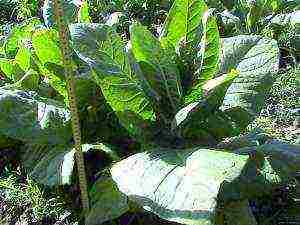 This species can be grown where the climate favors it. But at the moment, the best location for growing the Virginia variety is Africa, or rather the country of Zimbabwe, Brazil and some American states (Both Carolina, Georgia). It has already been said above that this variety contains a large amount of sugar, but nicotine in it, if we take the average component, is 2%.
This species can be grown where the climate favors it. But at the moment, the best location for growing the Virginia variety is Africa, or rather the country of Zimbabwe, Brazil and some American states (Both Carolina, Georgia). It has already been said above that this variety contains a large amount of sugar, but nicotine in it, if we take the average component, is 2%.
The Virginia variety goes through the traditional processing method. In order to preserve the color and its taste, a special steam dryer is used.Steam drying, or in other words smoke drying, is an artificial drying that is used to dry most types of tobacco. The process involves drying the leaves using chimneys through which hot air enters the barn. This type of drying is considered fast. It gives the leaves a yellow tint. After drying is over, the leaves are left in the shed for several days so that they have time to absorb the remaining moisture from the air. If you thought that this is all, then it is not so. After the leaves have passed all the main drying stages, they are transported to the tobacco factory, where they will be aged for several more years. As soon as the aging process comes to an end, the leaves are separated from the stems and prepared for sale, that is, they are distributed according to quality and color.
Burleigh
The main difference between this species is its nutty taste. Burleigh is brown, but also red. Unlike 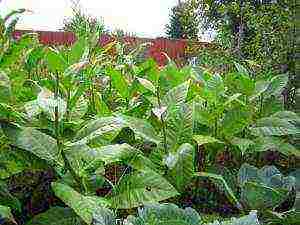 from the variety "Virginia" that was described above, "Burley" practically does not contain sugar, but nicotine in the composition of as much as 4%. Due to the low sugar content in tobacco, it is often saturated with sweeteners so that it does not give off strong bitterness during use. The lack of sugar is expressed by the firmness and dryness of this Virginia variety.
from the variety "Virginia" that was described above, "Burley" practically does not contain sugar, but nicotine in the composition of as much as 4%. Due to the low sugar content in tobacco, it is often saturated with sweeteners so that it does not give off strong bitterness during use. The lack of sugar is expressed by the firmness and dryness of this Virginia variety.
The described type of tobacco takes the silver line in terms of content in tobacco mixes, of course, after the variety "Virginia". It is grown mainly in the USA and Mexico.
The leaves reach the desired condition by natural drying, that is, only the collected tobacco leaves are hung in a well-ventilated barn and there they already reach the desired degree of humidity, and natural ventilation of the room (wind) helps them in this. This is followed by the traditional aging, splitting and sorting process.
Latakia
This variety is the leader among "spicy" tobaccos. It is said that its scent cannot be confused with any other species. The cultivation of "Latakia" is currently only taking place in Cyprus.
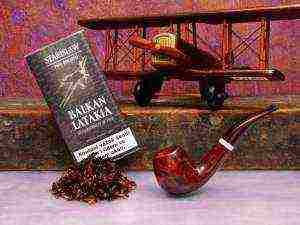 The aroma of this tobacco is peculiar - masculine, has a similarity to the aroma of incense. Because of its peculiar smell, this variety is not suitable for everyone, but in England they love it very much and add it to almost all tobacco mixes. These mixtures contain 40-45% of this tobacco. If you are interested in trying pure Latakia tobacco, then do not forget that this is a saturated tobacco that burns poorly and dries out the nasopharynx. Those wishing to appreciate the taste of this variety simply have to try the following tobacco mixes: LondonMixture or EarlyMorningPipe from Dunhill tobacco company.
The aroma of this tobacco is peculiar - masculine, has a similarity to the aroma of incense. Because of its peculiar smell, this variety is not suitable for everyone, but in England they love it very much and add it to almost all tobacco mixes. These mixtures contain 40-45% of this tobacco. If you are interested in trying pure Latakia tobacco, then do not forget that this is a saturated tobacco that burns poorly and dries out the nasopharynx. Those wishing to appreciate the taste of this variety simply have to try the following tobacco mixes: LondonMixture or EarlyMorningPipe from Dunhill tobacco company.
Drying of the leaves, after harvesting, occurs in the sun (naturally), and then the leaves are brought to the desired state with a dense stream of smoke emanating from a burning tree, which completely covers the leaves with soot. Usually oak or pine is fired. As a result, it turns out, a kind of hot smoked tobacco. Drying lasts several months until the tobacco leaves are completely blackened.
Parik
This variety is very rare, but unusually fragrant. It has a black color and a firm structure that very much resembles leather, it goes well with a delicate and pleasant aroma. The aroma combines the scent of compote, while the aroma is intense, which is even felt by people standing nearby. This type has a high content of nicotine and, as a rule, it is used in mixes, but with the addition of no more than 5%.
Oriental
The name of this species speaks of its origin - the Eastern Mediterranean. His homeland is Cyprus, Greece and Turkey. It is cultivated there to this day. Countries from the Balkan Peninsula have also begun to cultivate this species.
Now about the properties. There is less sugar in this form than in Virginia. Due to the small amount of sugar in tobacco, it has a sweet and sour taste and a dry herb smell. This combination cannot be confused with another type of tobacco.It is very often used in English-style blends such as OrientalMixture.
Tobacco leaves, after being harvested, are dried in the sun. In tobacco mixes, it is easily recognizable due to its greenish-yellow hue.
Kentucky
This variety is a specially processed type of another variety of tobacco, which was described above - Burleigh. Its production is carried out in the state of Kentucky (USA), in Malaysia. The main difference in obtaining this variety is that, unlike Burley, which is air-dried, this one is fire-dried. Yes, it does not have the same smoky aroma as Latakia, but it has a peculiar taste that is quite distinguishable, which makes it special. Also, this variety contains a high amount of nicotine, which, as everyone has already guessed, involves the use of a small amount of it in mixtures. It is not recommended to use it in its pure form.
Cavendish
This variety is an independent species though, and is made by a mix of Virginia and Burley varieties, which are specially processed. When creating this type of tobacco, other types can also be used, such as in Dutch mixes.
 A bit of history. Cavendish is the name of the famous captain of English descent. One day, returning from the Caribbean to England, there were many empty rum barrels on the ship. For the captain's reasons, it was unreasonable to transport empty barrels and ordered to put tobacco in them. Upon arrival home, it became known that aging in wooden barrels is only good for him. The tobacco was saturated not only with rum - the heat and natural ventilation of the room during storms made it not only soft, but also fragrant. Thus, it follows that the cargo has gone through the splitting process more than once, being in barrels under pressure. This process lowered the level of nicotine in the tobacco and freed itself of all volatile compounds. This is how a new species appeared - the Cavendish.
A bit of history. Cavendish is the name of the famous captain of English descent. One day, returning from the Caribbean to England, there were many empty rum barrels on the ship. For the captain's reasons, it was unreasonable to transport empty barrels and ordered to put tobacco in them. Upon arrival home, it became known that aging in wooden barrels is only good for him. The tobacco was saturated not only with rum - the heat and natural ventilation of the room during storms made it not only soft, but also fragrant. Thus, it follows that the cargo has gone through the splitting process more than once, being in barrels under pressure. This process lowered the level of nicotine in the tobacco and freed itself of all volatile compounds. This is how a new species appeared - the Cavendish.
Today the American type "Cavendish" is made by the abundant addition of molasses. That is why tobacco has a combination of caramel aroma. It is necessary to clarify that not all types of Cavendish, based on Burleigh, are saturated with flavorings. Natural tobacco, for example, is made in the state of Kentucky. In addition, most of the Cavendish varieties created on the basis of Virginia tobacco are natural. No additives or flavors are used in their manufacture.
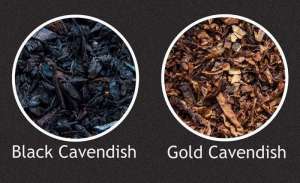 Black Cavendish is also made from Virginia, which gets its name from its black color, which is obtained through special processing. It is possible to dry tobacco both by air method and in drying chambers - not fundamentally. An interesting fact is that the preparation of natural "Cavendish", obtained from "Virginia", takes place more than once fermentation, and then it is folded in dark rooms for storage. Moreover, this species will have to be stored longer than others. As a result, "Black Cavendish" is an aromatic and soft-tasting tobacco variety with a bright spicy aroma. In order to increase the saturation, manufacturers deliberately increase the temperature during fermentation.
Black Cavendish is also made from Virginia, which gets its name from its black color, which is obtained through special processing. It is possible to dry tobacco both by air method and in drying chambers - not fundamentally. An interesting fact is that the preparation of natural "Cavendish", obtained from "Virginia", takes place more than once fermentation, and then it is folded in dark rooms for storage. Moreover, this species will have to be stored longer than others. As a result, "Black Cavendish" is an aromatic and soft-tasting tobacco variety with a bright spicy aroma. In order to increase the saturation, manufacturers deliberately increase the temperature during fermentation.
No British blend is made without Cavendish tobacco.
There is a huge variety of tobacco varieties in the world, and in this article you learned about the most basic of them.

